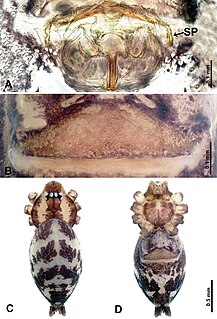
Aspergillus is a genus consisting of a few hundred mould species found in various climates worldwide.

Rhizopus is a genus of common saprophytic fungi on plants and specialized parasites on animals. They are found in a wide variety of organic substances , including "mature fruits and vegetables", jellies, syrups, leather, bread, peanuts, and tobacco. They are multicellular. Some Rhizopus species are opportunistic agents of human zygomycosis and can be fatal. Rhizopus infections may also be a complication of diabetic ketoacidosis. This widespread genus includes at least eight species.

Aspergillus oryzae, also known as kōji mold, is a filamentous fungus used in Japan to saccharify rice, sweet potato, and barley in the making of alcoholic beverages such as sake and shōchū, and also to ferment soybeans for making soy sauce and miso. However, in the production of fermented foods of soybeans such as soy sauce and miso, Aspergillus sojae is mainly used instead of A. oryzae. A. oryzae is also used for the production of rice vinegars. Barley kōji (麦麹) or rice koji (米麹) are made by fermenting the grains with A. oryzae hyphae.
Xanthomonas oryzae is a species of Proteobacteria. The major host of the bacterium is rice.

The Magnaporthaceae are a family of fungi in the order Magnaporthales. It was circumscribed by Paul F. Cannon in 1994 for a group of grass-associated fungi centered on Magnaporthe (Nakataea). Magnaporthaceae have a harpophora-like asexual morphology and are often associated with roots of grasses or cereals.

Oligonychus is a genus of mites in the family Tetranychidae, the spider mites. Many members of this genus are familiar pests of plants. There are about 200 described species.

Rhizopus oryzae is a filamentous heterothallic microfungus that occurs as a saprotroph in soil, dung, and rotting vegetation. This species is very similar to Rhizopus stolonifer, but it can be distinguished by its smaller sporangia and air-dispersed sporangiospores. It differs from R. oligosporus and R. microsporus by its larger columellae and sporangiospores. R. oryzae is used economically in the production of the enzymes, glucoamylase and lipase, in the synthesis of organic acids, and in various fermented foods. The many strains of R. oryzae produce a wide range of enzymes such as carbohydrate digesting enzymes and polymers along with a number of organic acids, ethanol and esters giving it useful properties within the food industries, bio-diesel production, and pharmaceutical industries. It is also an opportunistic pathogen of humans causing mucormycosis.
Merizocera brincki, is a species of spider of the family Psilodercidae. It is endemic to Sri Lanka.
Merizocera is a genus of six eyed spiders in the family Psilodercidae, first described by Jean-Louis Fage in 1912.
Merizocera cruciata is a species of spider of the family Psilodercidae. It is endemic to Sri Lanka.
Merizocera picturata, is a species of spiders of the family Psilodercidae. It is endemic to Sri Lanka.
Psiloderces is a genus of six eyed spiders in the family Psilodercidae, first described by Eugène Simon in 1892
Leclercera is a genus of spiders in the family Psilodercidae found in southeast Asia, including Thailand, Nepal, and the Philippines. It was first described in 1995 by Christa L. Deeleman-Reinhold, who named it after a fellow collector of Asian spiders. She originally placed under Ochyroceratidae, but it was later moved it to Psilodercidae. It is named for Philippe Leclerc, a collector of spiders in southeast Asia.

Psilodercidae is a family of spiders first described as a subfamily of Ochyroceratidae by Machado in 1951 and raised to family rank by J. Wunderlich in 2008. These spiders can be distinguished by the "segestriid positioning" of their six eyes, the absence of leg bristles, strong apical bristles on the cymbium, and several pairs of spermathecae in females.

Luzonacera is a genus of spiders in the family Psilodercidae. It was erected by Feng-Yuan Li and Shu-Qiang Li in 2017. As of February 2019, it contains five species found on the Philippine island of Luzon.
Priscaleclercera is a genus of araneomorph spiders in the family Psilodercidae, containing seven species. The genus was first described by Jorge Wunderlich in 2017, and its fossils have been found in Burmese amber, while live specimens have been found in Indonesia (Sulawesi).
Relictocera is a genus of southeast Asian araneomorph spiders in the family Psilodercidae, containing the single species, Relictocera qiyi. It was first described by F. Y. Li & S. Q. Li in 2017, and has only been found in Vietnam.







